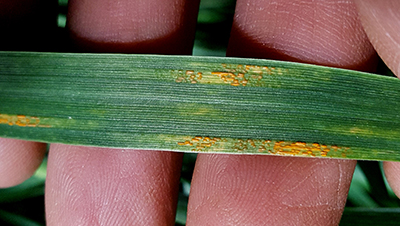The 2017 wheat season is underway in Michigan
Some considerations as wheat nears the green-up stage.

Early spring marks the time when wheat growers begin implementing their wheat production strategies. The first step, once the wheat fields regain active green tissue (green-up), is to confirm each field has successfully survived the winter months. So far in Michigan no significant damage is foreseen. Nevertheless, spring stresses such as repeated freezing, thawing of the soil and extended periods of wet soil can potentially lead to plant loss in the weeks to come. Ultimately, the best evidence of healthy wheat plants occurs soon after the onset of green-up when the plant crowns begin generating new root growth. Generally, if there are 10 or more surviving seedlings per foot of row, growers may still achieve 90 percent of their yield potential.
Another practice at this time of year is to spread red clover seed in stands of wheat to serve as a cover crop. While some have already completed this task, the application window extends into wheat’s green-up stage. Using 10 to 12 pounds of inoculated seed is usually sufficient for achieving a dense cover. See the Michigan State University Extension article “Frost seeding red clover into winter wheat” for more information.
Nitrogen fertilization is another key input. The best timing of nitrogen application is difficult to discern as much depends on weather, particularly related to rainfall. Assuming wheat stands appear healthy and there are a couple tillers per plant, delaying nitrogen fertilization until full-tillering is a reasonable option. See “Spring N application timing for Michigan winter wheat management” by MSU Extension for more information.
Where early applications might best fit is where late-planted stands have little or no tillering, or where the stands lack normal vigor. Conversely, where wheat was planted early leading to extensive tillering, delaying an application until full-tillering may be prudent in order to avoid excessive tillering and plant lodging.
Spring is also the time to insure you have a strategy to address any leaf or head diseases that may occur as the season progresses. Clearly, Fusarium head scab is among these as it is a perennial concern, particularly fields hosting a susceptible variety. However, you should also be prepared to react to stripe rust if an outbreak occurs similar to last year (2016).

Stripe rust on wheat.
Based on last season’s experience, you do not need to make a preemptive fungicide application. Rather, wait to see if the disease actually develops. Where it does, you should apply a fungicide before or at the time of flag leaf emergence. (During 2016, delaying a fungicide application until flowering failed to adequately control stripe rust on susceptible varieties.)
Last season’s unprecedented outbreak did provide MSU researchers an opportunity to rate varieties’ relative resistance to the disease—see “Stripe rust susceptibility of Michigan wheat varieties.” Relative ranking identifies varieties as being resistant, moderately resistant, moderately susceptible or susceptible. All but the resistant varieties should be scouted for stripe rust.



 Print
Print Email
Email


